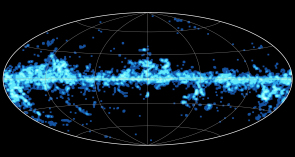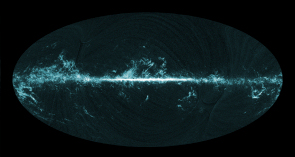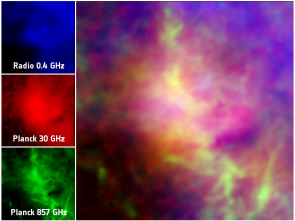Delving through the Milky Way with Planck
The contaminants include emissions from galaxies, galaxy clusters and, most crucially, from diffuse material within our own Galaxy, the Milky Way. The careful removal of foreground emissions that is necessary to uncover the cosmological potential of Planck's data had a very valuable by-product: the delivery of large data sets to many other fields in astrophysics.
The interstellar medium (ISM) that permeates the Milky Way shines brightly in all of Planck's wavelength channels via a variety of radiation processes. The main causes of this diffuse radiation are free electrons at the longest wavelengths, and dust grains at the shortest wavelengths probed by Planck.
Data from Planck were used to compile maps of the various components of the ISM, revealing in the process some new players contributing to our Galaxy's emission.
With the new data, astronomers studied a mysterious emission that was detected several years ago at microwave wavelengths, confirming that its origin can be explained by spinning dust grains and that it is widespread in the ISM. Another study of Planck's maps enabled the astronomers to better quantify the amount of gas in molecular clouds where stars are being born. Locating and quantifying gas in molecular clouds is a vexed issue in the study of star formation since molecular hydrogen, the gas from which stars take shape, does not emit and must be traced indirectly. To this aim, astronomers have exploited the data from Planck to obtain the first all-sky map of the emission from carbon monoxide, a molecule that traces the densest pockets of gas where star formation is taking place across the Galaxy.
A study using some of the early data collected by Planck produced a chart of the densest and coldest cores across the Galaxy, where the earliest steps of star formation take place. This catalogue proved a very helpful resource for follow-up studies of these stellar cradles with higher resolution observations, including some performed with ESA's Herschel Space Observatory.






